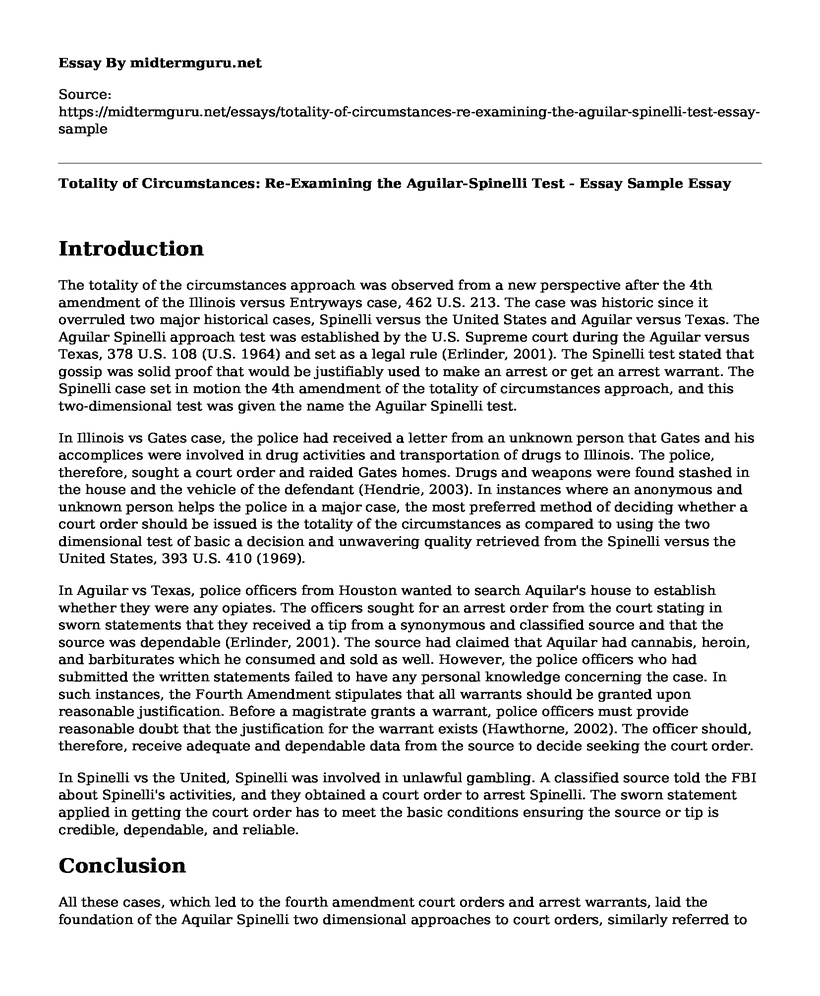Introduction
The totality of the circumstances approach was observed from a new perspective after the 4th amendment of the Illinois versus Entryways case, 462 U.S. 213. The case was historic since it overruled two major historical cases, Spinelli versus the United States and Aguilar versus Texas. The Aguilar Spinelli approach test was established by the U.S. Supreme court during the Aguilar versus Texas, 378 U.S. 108 (U.S. 1964) and set as a legal rule (Erlinder, 2001). The Spinelli test stated that gossip was solid proof that would be justifiably used to make an arrest or get an arrest warrant. The Spinelli case set in motion the 4th amendment of the totality of circumstances approach, and this two-dimensional test was given the name the Aguilar Spinelli test.
In Illinois vs Gates case, the police had received a letter from an unknown person that Gates and his accomplices were involved in drug activities and transportation of drugs to Illinois. The police, therefore, sought a court order and raided Gates homes. Drugs and weapons were found stashed in the house and the vehicle of the defendant (Hendrie, 2003). In instances where an anonymous and unknown person helps the police in a major case, the most preferred method of deciding whether a court order should be issued is the totality of the circumstances as compared to using the two dimensional test of basic a decision and unwavering quality retrieved from the Spinelli versus the United States, 393 U.S. 410 (1969).
In Aguilar vs Texas, police officers from Houston wanted to search Aquilar's house to establish whether they were any opiates. The officers sought for an arrest order from the court stating in sworn statements that they received a tip from a synonymous and classified source and that the source was dependable (Erlinder, 2001). The source had claimed that Aquilar had cannabis, heroin, and barbiturates which he consumed and sold as well. However, the police officers who had submitted the written statements failed to have any personal knowledge concerning the case. In such instances, the Fourth Amendment stipulates that all warrants should be granted upon reasonable justification. Before a magistrate grants a warrant, police officers must provide reasonable doubt that the justification for the warrant exists (Hawthorne, 2002). The officer should, therefore, receive adequate and dependable data from the source to decide seeking the court order.
In Spinelli vs the United, Spinelli was involved in unlawful gambling. A classified source told the FBI about Spinelli's activities, and they obtained a court order to arrest Spinelli. The sworn statement applied in getting the court order has to meet the basic conditions ensuring the source or tip is credible, dependable, and reliable.
Conclusion
All these cases, which led to the fourth amendment court orders and arrest warrants, laid the foundation of the Aquilar Spinelli two dimensional approaches to court orders, similarly referred to as the Aguilar Spinelli test (Hendrie, 2003). The test deals with situations where a court has to provide and authorize an arrest seizure. The prongs established by the Spinelli approach are as follows: The magistrate has to be educated to establish that the witness is credible and data presented is solid and dependable, and secondly, the magistrate has to be knowledgeable of the reasons and circumstances that made the person provide information to the police. The Aguilar court stipulated that the quality of data presented and the credibility of the witness had to be autonomously provided.
References
Erlinder, P. (2001). Florida v. JL--Withdrawing Permission to Lie with Impunity: The Demise of Truly Anonymous Informants and the Resurrection of the Aguilar/Spinelli Test for Probable Cause. U. Pa. J. Const. L., 4, 1. https://www.google.com/url?sa=t&rct=j&q=&esrc=s&source=web&cd=1&cad=rja&uact=8&ved=2ahUKEwjxhqnO5vfiAhWQx4UKHbJRBr4QFjAAegQIAhAC&url=https%3A%2F%2Fscholarship.law.upenn.edu%2Fcgi%2Fviewcontent.cgi%3Farticle%3D1392%26context%3Djcl&usg=AOvVaw08SQCLK2BnSkT8bafBseWS
Hawthorne, P. G. (2002). Tips, Returning to and Improving upon Aguilar-Spinelli: A Departure from the Gates Totality of the Circumstances. Howard LJ, 46, 327.
Hendrie, E. M. (2003). When an Informant's Tip Gives Officers Probable Cause to Arrest Drug Traffickers. FBI L. Enforcement Bull., 72, 8. https://www.ncjrs.gov/App/Publications/abstract.aspx?ID=203544
Cite this page
Totality of Circumstances: Re-Examining the Aguilar-Spinelli Test - Essay Sample. (2023, Jan 23). Retrieved from https://midtermguru.com/essays/totality-of-circumstances-re-examining-the-aguilar-spinelli-test-essay-sample
If you are the original author of this essay and no longer wish to have it published on the midtermguru.com website, please click below to request its removal:
- Should There Be a Future Role for UN Peacekeeping Troops in Afghanistan?
- Commemorative Speech: The Legacy of Jamal Khashoggi
- Essay Sample on Laredo Police Department
- Essay Sample on Equity, Justice and Human Dignity
- Research Paper on International Relation: War Between the U.S. And North Korea
- High Prevalence of Unions in Northern, Midwest, and Western States Than in the Southern States
- Article Analysis Essay on "Frederick Douglass's Rhetorical Legacy"







